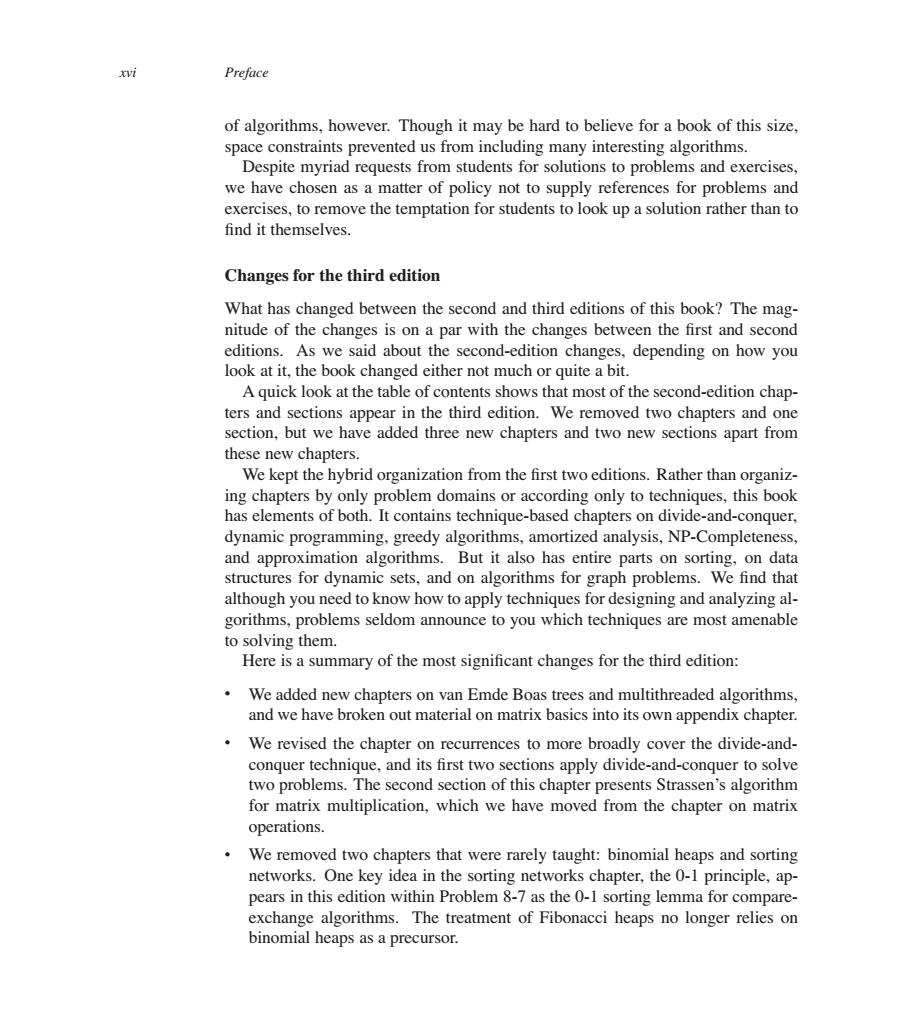正在加载图片...

xvi Preface of algorithms,however.Though it may be hard to believe for a book of this size, space constraints prevented us from including many interesting algorithms. Despite myriad requests from students for solutions to problems and exercises, we have chosen as a matter of policy not to supply references for problems and exercises,to remove the temptation for students to look up a solution rather than to find it themselves. Changes for the third edition What has changed between the second and third editions of this book?The mag- nitude of the changes is on a par with the changes between the first and second editions.As we said about the second-edition changes,depending on how you look at it,the book changed either not much or quite a bit. A quick look at the table of contents shows that most of the second-edition chap- ters and sections appear in the third edition.We removed two chapters and one section,but we have added three new chapters and two new sections apart from these new chapters. We kept the hybrid organization from the first two editions.Rather than organiz- ing chapters by only problem domains or according only to techniques,this book has elements of both.It contains technique-based chapters on divide-and-conquer, dynamic programming,greedy algorithms,amortized analysis,NP-Completeness, and approximation algorithms.But it also has entire parts on sorting,on data structures for dynamic sets,and on algorithms for graph problems.We find that although you need to know how to apply techniques for designing and analyzing al- gorithms,problems seldom announce to you which techniques are most amenable to solving them. Here is a summary of the most significant changes for the third edition: We added new chapters on van Emde Boas trees and multithreaded algorithms, and we have broken out material on matrix basics into its own appendix chapter. We revised the chapter on recurrences to more broadly cover the divide-and- conquer technique,and its first two sections apply divide-and-conquer to solve two problems.The second section of this chapter presents Strassen's algorithm for matrix multiplication,which we have moved from the chapter on matrix operations. We removed two chapters that were rarely taught:binomial heaps and sorting networks.One key idea in the sorting networks chapter,the 0-1 principle,ap- pears in this edition within Problem 8-7 as the 0-1 sorting lemma for compare- exchange algorithms.The treatment of Fibonacci heaps no longer relies on binomial heaps as a precursor.xvi Preface of algorithms, however. Though it may be hard to believe for a book of this size, space constraints prevented us from including many interesting algorithms. Despite myriad requests from students for solutions to problems and exercises, we have chosen as a matter of policy not to supply references for problems and exercises, to remove the temptation for students to look up a solution rather than to find it themselves. Changes for the third edition What has changed between the second and third editions of this book? The magnitude of the changes is on a par with the changes between the first and second editions. As we said about the second-edition changes, depending on how you look at it, the book changed either not much or quite a bit. A quick look at the table of contents shows that most of the second-edition chapters and sections appear in the third edition. We removed two chapters and one section, but we have added three new chapters and two new sections apart from these new chapters. We kept the hybrid organization from the first two editions. Rather than organizing chapters by only problem domains or according only to techniques, this book has elements of both. It contains technique-based chapters on divide-and-conquer, dynamic programming, greedy algorithms, amortized analysis, NP-Completeness, and approximation algorithms. But it also has entire parts on sorting, on data structures for dynamic sets, and on algorithms for graph problems. We find that although you need to know how to apply techniques for designing and analyzing algorithms, problems seldom announce to you which techniques are most amenable to solving them. Here is a summary of the most significant changes for the third edition: We added new chapters on van Emde Boas trees and multithreaded algorithms, and we have broken out material on matrix basics into its own appendix chapter. We revised the chapter on recurrences to more broadly cover the divide-andconquer technique, and its first two sections apply divide-and-conquer to solve two problems. The second section of this chapter presents Strassen’s algorithm for matrix multiplication, which we have moved from the chapter on matrix operations. We removed two chapters that were rarely taught: binomial heaps and sorting networks. One key idea in the sorting networks chapter, the 0-1 principle, appears in this edition within Problem 8-7 as the 0-1 sorting lemma for compareexchange algorithms. The treatment of Fibonacci heaps no longer relies on binomial heaps as a precursor.���